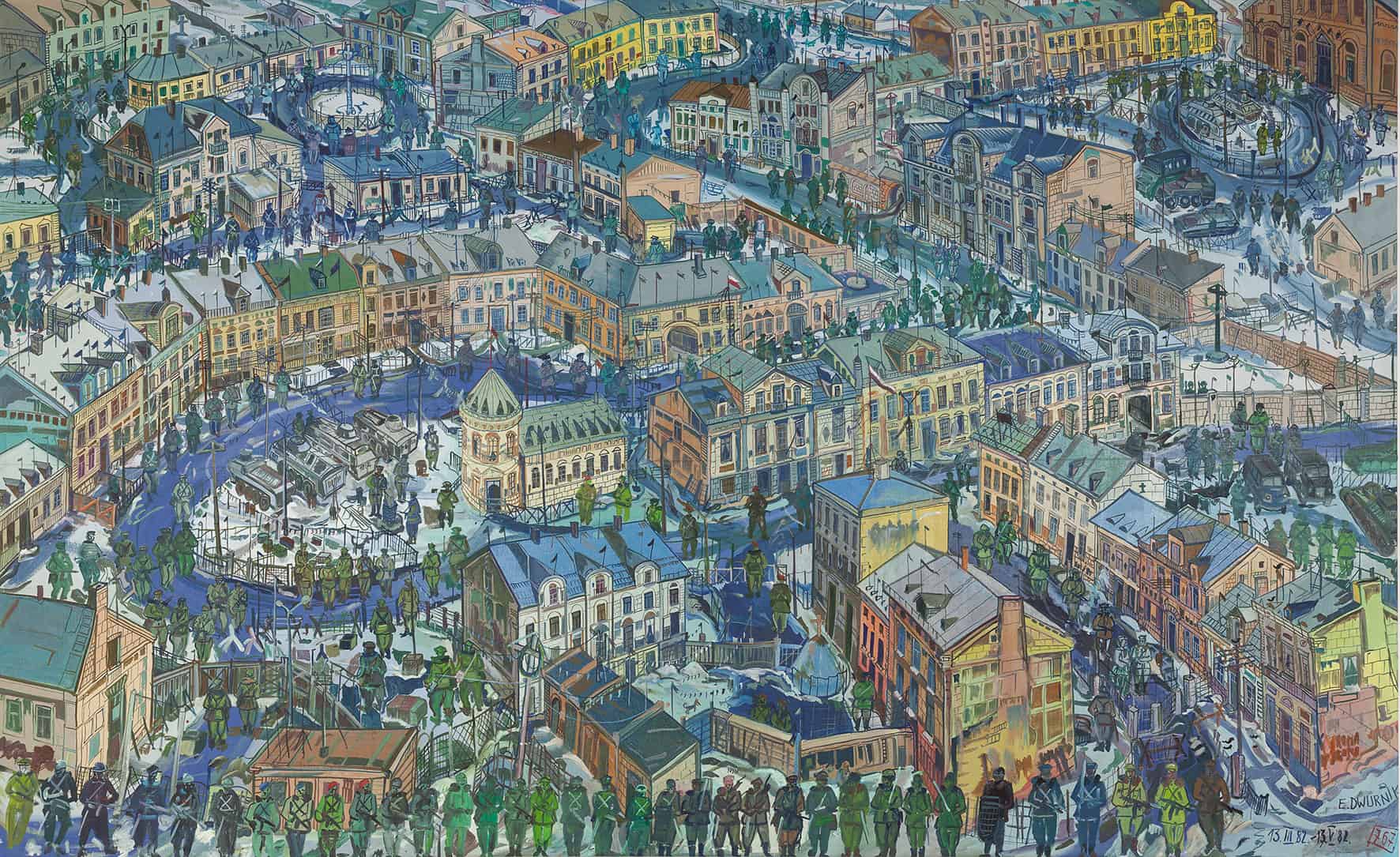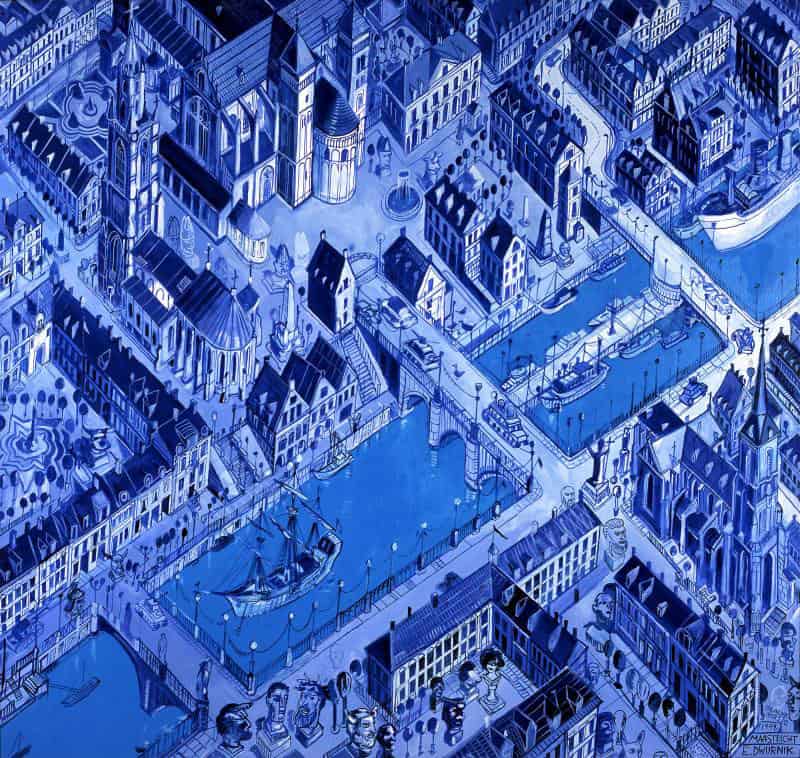We were deeply saddened by the news of Edward Dwurnik passing away on 28 October 2018. He was an outstanding Polish painter and an unconventional figure, recognised internationally. Many people also considered him highly controversial. Through his long years of artistic activity, this exceptional painter developed his own language and means of expression. He used this language to portray Polish society, inhabitants of big cities, members of various social groups and, finally, the current political situation. His unbeatable talent to use caricature, irony and critical commentary with a dose of warmth and affection provided for an unmatched mixture that made depicted scenes truly unique. In addition to his socially engaged works, he also painted nudes, flowers and abstract expressionist works inspired by Jackson Pollock, with a similar extravaganza of colour.
Dwurnik was born in 1943. In the 1970s he was a student at the Academy of Fine Arts in Warsaw. His relationship with the Academy did not cease on the day of his graduation but continued until the final days of his work as a painter. He was married to Teresa Gierzyńska, a Polish photographer who tackles feminism in her works. Here are six facts about the life and work of Edward Dwurnik worth knowing to enjoy your experience with his works to the fullest.
“Hitchhiking Trips”
This is the oldest and largest of Dwurnik’s series of paintings. He started to work on it as early as 1966. The series features townscapes or rather “portraits” of Polish cities and towns. There is an extraordinary abundance of details on each of these images, and this is what makes the series so expressive. What we get looking at these paintings are evocative illustrations presenting places that the artist had a chance to visit. We cannot see the horizon on these stunning vedute. Perspective and proportions are distorted with topography presented from the bird’s eye view. In the pictures, we can see people in the streets bustling about their daily business. Usually, however, they are depicted in a caricatural manner. Dwurnik paid the same meticulous attention to every little detail depicted on the canvas. The artist openly admitted his deep fascination with naïve art, and the grotesque and naivety in his works were inspired by the painter Dwurnik admired the most – Nikifor Krynicki.

Edward Dwurnik, Obława na groźnego bandytę, 1982, oil, on the canva, 250 x 410 cm, MOCAK collection, photo: R. Sosin
“Blue Warsaws”
A series entitled “Blue Warsaws” includes over 40 paintings presenting the capital city of Poland. Their distinctive character stems from the fact that they were all painted in 1981, just after martial law was declared in Poland. These vedutas present certain military motives along with the usual townscapes. The artist imagined Warsaw after the war came back, with streets full of tanks, entanglements, soldiers and braziers filled with hot coals. Each picture in this series is monochrome, painted in various shades of blue. In painting, this colour traditionally denotes misery, despair and powerlessness.

Edward Dwurnik, Prague – Town Hall, 2008, courtesy Dom Aukcyjny Polswiss Art
“Sportsmen”
The series named “Sportsmen” was painted over the period from 1972 to 1992. It includes an impressive number of nearly 150 works featuring representatives of various social groups. Contrary to what the title may suggest, the sportsmen painted by Edward Dwurnik are not athletes, but smokers. They were addicted to nicotine and smoked “Sport”, which was the cheapest cigarette brand available in communist Poland. The group which the artist was most interested in are representatives of the lowest social class, very often poor, unemployed and hopeless. In this painting series, the artist presented a topology of human types inhabiting Poland ruled by communists. Their everyday life was of particular interest to him. All pictures are painted with the use of vivid colours and resemble illustrations from a comic book. They are also very expressive, to some extent similar to Neue Wilde art. Dwurnik didn’t shy away from showing brutality, vulgarity and taboos. His Sportsmen guzzle vodka, smoke like chimneys, throw up, hit on girls making indecent proposals, sip from large glasses of beer in second-rate bars and get into fistfights. They also have their dreams and ambitions. Some time passed since works in this series were painted and currently, they are often interpreted in a political context. What is more, they are considered a unique chronicle of the times, showing the collapse of the communist rule, the formation of blue-collar worker ethos and the impact that tumultuous transformation period exerted on Polish “everymen”. It was largely thanks to this painting series that Dwurnik started to be regarded as one of the best commentators of reality and social dynamics of the times.

Edward Dwurnik, Four workers and the factory, 1984, courtesy Dom Aukcyjny Polswiss Art
Inspired by masters of painting from the past
In 2010 Dwurnik painted his own version of the “Battle of Grunwald”, which was a variation of the famous painting by Jan Matejko. This enormous canvas painted in monochrome shades of blue was presented to the audience at the Wawel Castle. Even at first sight spectators can see a huge amount of tiny black figures which seem to be just a chaotic bunch or a peculiar-looking fight. Seen from a distance, they resemble a decorative element or a pattern on the fabric. While painting the “Battle” Dwurnik used his usual technique – the bird’s eye view perspective. The historical scene was modernised by adding props characteristic of our era. Three female figures wearing red dresses are crucial elements in the whole composition, as they set diagonal line from the top left to the bottom right corner. The new “Battle of Grunwald” which Dwurnik created is neither pastiche nor a caricature of the precursor. It is, however, an attempt to engage in a dialogue with the famous painter from the past. Last but not least, it shows how vital cultural heritage was for Edward Dwurnik.

Edward Dwurnik, ‘Prussian Homage’, sketch, 2010, ink on the carton, 46 x 55 cm, MOCAK Collection, photo: R. Sosin
Compulsive creator
Until his final days, Dwurnik was active as an artist. He told his audience about his everyday life through the extended interview which in 2016 was published as a book entitled “Moje królewstwo. Rozmowa z Edwardem Dwurnikiem” (My Kingdom. Interview with Edward Dwurnik). The answers he gave to Małgorzata Czyńska, who interviewed the artist on behalf of Czarne publishing house, reveal interesting and sometimes surprising details from the life of this intriguing person. He tells the interviewer about his “compulsive need to paint”, which made him paint multiple pictures every day. Recently many of these works were sent to artworks auctions as soon as they were finished, still smelling of fresh paint. The distinctive feature which helped identify Dwurnik’s paintings on the market was the recurrent motif of decorative, colourful tulips. Dwurnik himself was a passionate collector of modern artworks and photographs.

Edward Dwurnik, Galicja, 1998, arcylic, canvas, 151 x 210 cm, courtesy Fundacja Sztuki Polskiej ING
The family of artists
The daughter of Edward Dwurnik, Pola Dwurnik, is an artist who lives in Berlin and Warsaw. She creates drawings and watercolour pictures, as well as paintings showing the libertarian life of Berlin bohemia and criticising artistic establishment. The father and the daughter had a very good relationship and inspired each other. On numerous occasions they even worked together on new projects. In 2013 Pola published a book in English entitled “Girl on Canvas” which elaborates on the reception of famous paintings in a highly intimate and subversive manner. The book emphasises the fact that artworks can be interpreted in highly diverse ways, depending on personal experiences. It also highlights the perspective of her female peers with their own way of interacting with artworks. Edward Dwurnik was married to the famous photographer Teresa Gierzyńska, who documented her husband’s life as an artist throughout the years. She is also an author of many important photo series. Her works focussed on femininity, eroticism, close family and intimacy.

Edward Dwurnik, Plac Trzech Krzyży, 2002, watercolor, paper, 45 x 55 cm, courtesy Fundacja Sztuki Polskiej ING







